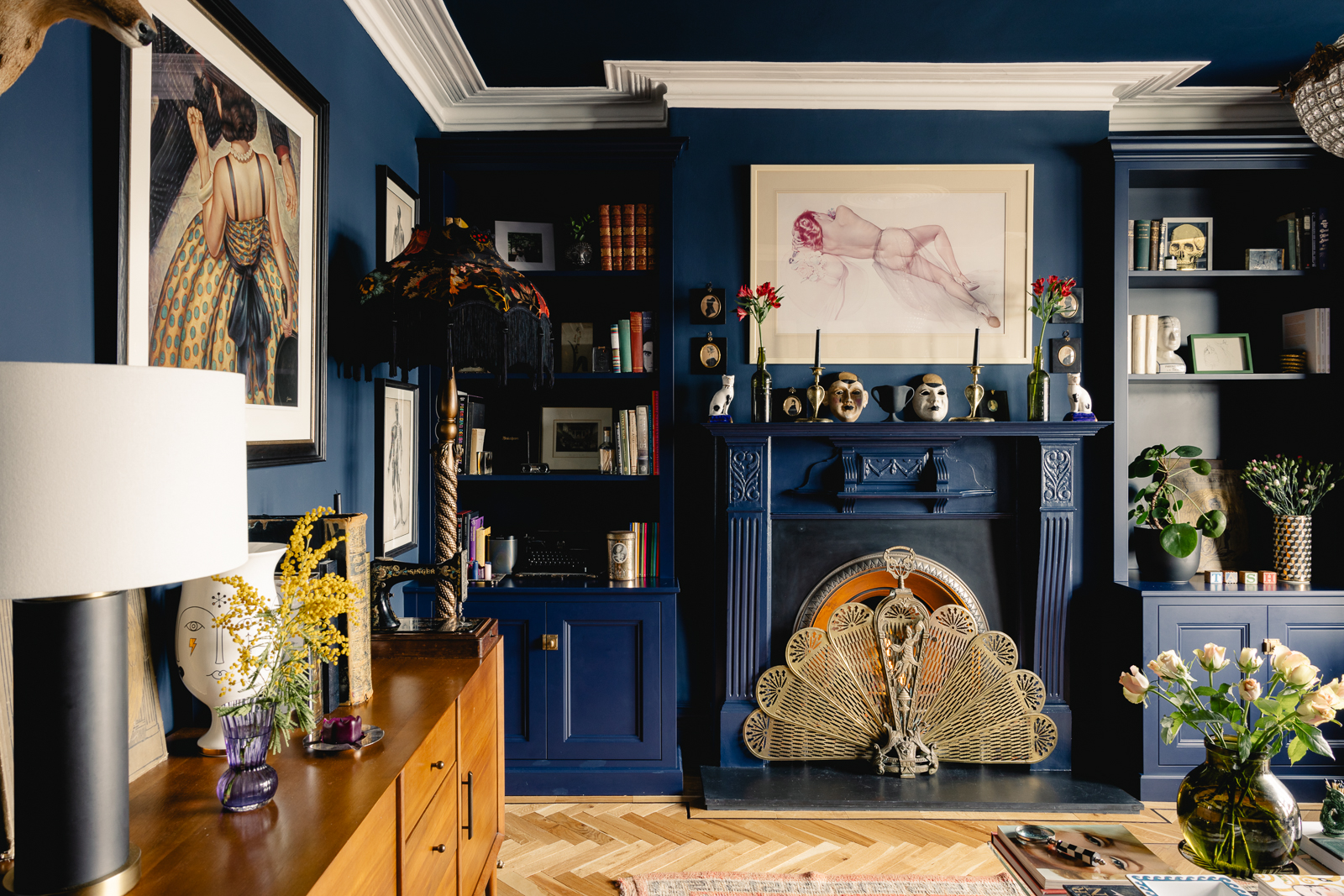A private driveway with stone setts leads up to the house where raised shrubs frame the entranceway; a Pod Point electric car charger is set to one side. Built with Imperial facing red brick, the house has an original restored clay-tile roof. Canted bay windows have beautiful cornice details and architraves set above and are painted Off Black by Farrow & Ball. Wisteria has been carefully trained to wind through the arches of the porch offering an incredible bloom and scent in early Spring.
Entry is to the spacious hallway. A chimneypiece with a fire grate is positioned to the side; a butler’s seat forms the base of the stairwell. Flooring throughout the ground floor is hand-laid oak parquet. Five-panel interior doors lead to reception rooms and have been carefully stripped to reveal a glorious patina.
To the right is the sitting room painted in Old Navy by Benjamin Moore. Sympathetically-designed cabinetry has been built into alcoves beside the grand chimneypiece, which has a burnished-iron insert and is fitted for a gas fire. An original drinks cabinet is set into the side of the bay and has a leaded glass door. The dining room looks out to the garden through French windows and is painted in Midnight Dream by Benjamin Moore; a glass-doored butler hatch opens to the kitchen.
The kitchen is a generous space; an original built-in dresser is finished in rich pink, and newer complimentary cupboards are painted in Duck Green by Farrow & Ball. Thick granite rests atop, and decorative brass handles are by
Armac Martin. A double butler sink looks out through twin sash windows; two corresponding skylights are set into the roof’s pitch, allowing the room to be flooded with light. The kitchen leads to a large conservatory and utility area, where a bank of tripartite French windows lead to the garden’s terrace.
The staircase ascends to the first floor and is laid with a striped wool runner by
Roger Oates Design. A spacious landing leads to two bedrooms and a bathroom. The main bedroom is painted in Jewel Beatle by Little Greene; deep wardrobes have been built into the alcoves. The second bedroom features an original chimneypiece and has an excellent garden view.
The family bathroom features nickel brassware from
Lefroy Brooks’ Mackintosh range. A cast-iron roll-top bath from the
Cast Iron Bath Company is set beside the window, and there is a rainfall shower encased in glass; dark green glazed Edwardian-style tiles are from
Fired Earth. At the apex of the house is the third bedroom, a spacious room with excellent views of the cityscape beyond, through windows set into the roof’s pitch.
The Great Outdoors
South-west facing, the vast garden is one of the largest in the area. The plot forms a wide strip and has been beautifully landscaped into a series of areas leading from the main house and ending with a discreetly positioned garage.
A spacious terrace with slate underfoot leads from the conservatory to a raised rock garden with ferns and a grand old conifer tree. A pea gravel path leads to an expansive greenhouse and spacious lawn. A stunning and mature Eucalyptus tree is set to one side. Planting throughout is mature, with some trees thought to have been planted when the house was built and includes dahlias, fuchsias, hydrangeas, peonies, and David Austin roses. Of particular note is a very old apple tree that offers a wonderful crop come early Autumn and a beautiful tall Acer.
Out and About
Epping Forest is exceptionally close by; entry is at the end of Mornington Road. On entering the magical depths of the forest, a footpath leads to Pole Hill, where T.E Lawrence once resided and dreamed of setting up a printing press for fine books. Views from here extend to the entire city beyond and lead into the enchanted woods where woodpeckers rest high above and deer roam freely.
Local amenities are excellent. The nearest Waitrose is a 10-minute drive away at Buckhurst Hill, while
Gail’s Bakery and
The Ginger Pig butchers are in nearby Loughton. Favoured local restaurants include
Trattoria Ibleo for woodfired Sicilian pizza
Rusty Bike for excellent Thai and beer. Big Al’s Bagels is famed for their salt beef, while
Café Dada is the preferred choice for coffee connoisseurs.
There is an excellent choice of local schools. Yardley Forest Nursery is in a beautiful lodge at the edge of the forest and accommodates children up to five years old. St Mary’s primary school is a five-minute walk away from Mornington Road and is rated Outstanding by Ofsted. The incredibly popular Forest School and Bancroft’s have a co-ed intake from prep through to A-level.
Transport links are excellent. Chingford station is a five-minute walk, with trains reaching Liverpool Street station in 25 minutes, while Oxford Circus can be reached in 35 minutes. Crossrail connections at Liverpool Street via the Elizabeth line (due to open later in 2022) will make journey times to Heathrow incredibly fast with just one change. Stanstead Airport is just a 30-minute drive away, and fashionable Walthamstow Village is 20 minutes away by train.
Council Tax Band: E
